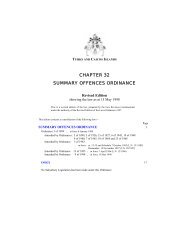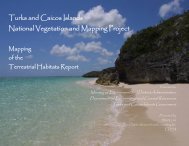rescue and collection of endemic and endangered plant species for
rescue and collection of endemic and endangered plant species for
rescue and collection of endemic and endangered plant species for
You also want an ePaper? Increase the reach of your titles
YUMPU automatically turns print PDFs into web optimized ePapers that Google loves.
Lessons Learned:<br />
1. It is possible to <strong>rescue</strong> <strong>and</strong>/or collect <strong>plant</strong>ing materials from areas on the brink <strong>of</strong><br />
destruction due to anthropogenic actions in the guise <strong>of</strong> development.<br />
2. Plants respond to various <strong>rescue</strong> methods. Not all <strong>plant</strong>s could be <strong>rescue</strong>d<br />
through balling. Some <strong>plant</strong>s are easier <strong>and</strong> more practical to collect seeds than<br />
balling the whole <strong>plant</strong>.<br />
3. It is important to have a <strong>rescue</strong> program authorized by the government so that<br />
<strong>plant</strong> <strong>species</strong> that are locally or internationally important would not decimate.<br />
4. Proper dissemination <strong>of</strong> the advantages <strong>of</strong> the <strong>rescue</strong> operation draws support<br />
from the concerned individuals <strong>and</strong> groups.<br />
5. A <strong>species</strong> specific propagation protocol is important as some <strong>species</strong> do not<br />
respond to generalized method <strong>of</strong> propagation.<br />
6. Rescued <strong>plant</strong>s or germinated seeds require suitable area (shaded nursery) to<br />
grow where appropriate care <strong>and</strong> maintenance are provided be<strong>for</strong>e they are<br />
out<strong>plant</strong>ed.<br />
7. The orchids can be propagated using modified agar <strong>and</strong> flasking method.<br />
Recommendations:<br />
1. The <strong>rescue</strong> <strong>of</strong> <strong>endemic</strong> <strong>and</strong> <strong>endangered</strong> <strong>plant</strong> <strong>species</strong> should be continued <strong>and</strong><br />
focus <strong>of</strong> <strong>collection</strong> remains the same – proposed <strong>and</strong> on-going development<br />
sites.<br />
2. Rescued <strong>plant</strong> should be out- <strong>plant</strong>ed in selected sites such as the Botanical<br />
gardens or road side <strong>plant</strong>ing, as appropriate, to showcase that rescuing <strong>plant</strong>s is<br />
a viable approach to maintain biological diversity, in addition to enhancing the<br />
aesthetic value <strong>of</strong> the site.<br />
3. Awareness campaign should be conducted at various levels (schools,<br />
business/corporate groups, <strong>and</strong> government <strong>of</strong>ficials/policy making bodies).<br />
Project Staff:<br />
Technical Staff: Bryan Manco<br />
Eric F. Salamanca<br />
Support Staff: Judnel Blaise - North Caicos Nursery<br />
Kenol Joseph – Providenciales Nursery<br />
Jacques Pierre – Providenciales Nursery<br />
DECR Administrative Staff who directly supported the project:<br />
22<br />
Wesley Clerveaux – Director<br />
Jewel Batchasingh – Deputy Director<br />
Marlon Hibbert – Scientific Officer<br />
Leroy Brooks – Deputy Conservation Officer<br />
Rhodriquez Ewing – Conservation Officer<br />
Lormeka Williams – NEC Curator/Acting Education Officer<br />
Volunteers: Turks <strong>and</strong> Caicos Environmental Club members<br />
JNCC- RESCUE AND COLLECTION OF ENDEMIC AND ENDANGERED PLANT SPECIES FOR<br />
BIODIVERSITY CONSERVATION/Project Completion Report/DECR-TCIG




